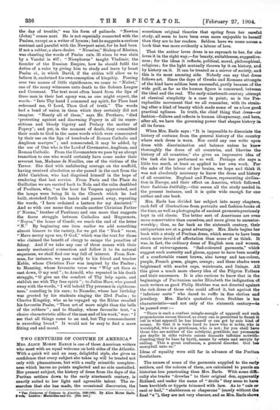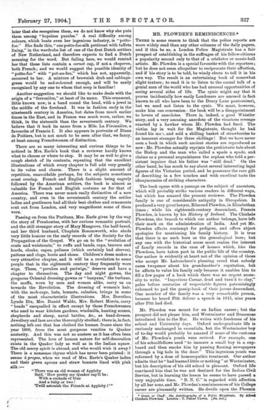TWO CENTURIES OF COSTUME IN AMERICA.* Mits. ALICE MORSE EARLE
is one of those American writers who meet with an equal welcome on both sides of the Atlantic. With a quick wit and an easy, delightful style, she gives us confidence that every subject she tikes up will be treated not only with pleasantness, but with a really scientific complete- ness which leaves no points neglected and no side unstudied. Her present subject, the history of dress from the days of the Puritan settlers down to the early nineteenth century, is exactly suited to her light and agreeable talent. The re- searches that she has made, the occasional discoveries, the
• Two Centunes of Costume in America, 1680-1890. By Alice Morse Earle. 2 to); London Macmillan and Co. [21e, net]
sometimes original theories that spring from her careful study, all seem to have been even more enjoyable to herself than they are to her readers. Seldom have we come across at book that was more evidently a labour of love.
That the author loves dress is no reproach to her, for she loves it in the right way,—for beauty, suitableness, suggestive- ness; for the ideas it reflects, political, moral, philosophical, religious ; for the light mutually thrown by it on history, and by history on it. It can be treated as a mirror of society, and this is its most amusing side. Nobody can say that dress. follows art. Since the days of Greeks and Romans attempts. of the kind have seldom been successful, partly because of the wide gulf, as far as the human figure is concerned, between the ideal and the real. The early-nineteenth-century attempt at classical simplicity is a case in point; so is the Pre- raphaelite movement that we all remember, with its strain- ing after a kind of beauty which made some of us adore good practical ugliness. In truth, the chief thing that dress—or fashion—follows and reflects is human idiosyncrasy, and here, after all, we have the governing power that shapes history in all its forms.
When Mrs. Earle says : "It is impossible to dissociate the history of costume from the general history of the country where such dress is worn. Nor could any one write upon dress with discrimination and balance unless he knew thoroughly the dress of all countries, and likewise ther
history of all countries," she gives an impressive idea of the task she has performed so well. Perhaps she says a. little too much, at least as applied to her own work. For
the sake of the labour of her brains, we hope and think it was not absolutely necessary to know the dress and history of all countries. England and France, representing civilisa- tion in Europe, and their effect on America, which followed. their fashions dutifully,—this seems all the study needed in the present instance, and it is quite wide enough for one. author and one book.
Mrs. Earle has divided her subject into many chapters, each full of illustrations from portraits and fashion-books ot the time, as well as photographs of ancient garments preciously kept in old chests. The better sort of Americans are even more conservative than ourselves, and more given to ancestor- worship ; thus, so far back as the sixteenth century, their antiquarians are at a great advantage. Mrs. Earle begins her book with a study of Puritan dress, which seems to have been much more devoid of affectation than some of us think. It was, in fact, the ordinary dress of English men and women, shorn of extravagances. "Sad-coloured garments," which suggest such austerity and gloom, appear to have been mostly of a comfortable russet brown, also tawny and tan-colour, purple, French green, ginger, orange; and these shades were
brightened with scarlet caps, waistcoats, and linings. AM this gives a much more cheery idea of the Pilgrim Fathers. and their successors. It is also curious to know that in the. beginnings of Puritanism under Elizabeth the indignation of such writers as good Philip Stubbes was not directed againsb
the rich dress of those who could afford it, but against the " inferiour sorts" who dared to ruffle in fine clothes and jewellery. Mrs. Earle's quotation from Stnbbes is too characteristic—and not only of the sixteenth century--ta be 'passed over :—
"There is such a confuse mingle-mangle of apparell and such preponderous excess thereof, as every one is permitted to flaunt it out in what apparell he has himself or can get by anie kind of means. So that it is verie hard to know who is noble, who is worshipful, who is a gentleman, who is not; for you shall have those who are neither of the nobilytie, gentilitie, nor yeomanrie goe daylie in silks velvets satens damasks taffeties notwith- standing they be base by byrth, meane by estate and servyle by calling. This a great confusion, a general disorder. God bee- mereyfull unto us.'
Ideas of equality were still far in advance of the Puritan forefathers.
The names of some of the garments supplied to the early
settlers, and the colours of them, are calculated to puzzle an historian less penetrating than Mrs. Earle. With some dia.
culty she tracks "drowlas " to their original den, apparently Rolland, and under the name of " drolls " they seem to have been kerchiefs or tippets trimmed with lace. As to " cale or
caul or kail," " shabberoon or chaperone" (surely without the final "e "), they are not very obscure, and as Mrs. Earle shows
later that she recognises them, we do not know why she puts them among "hopeless puzzles." A real difficulty among colours, which beats even her ingenious industry, is " potto- foo." She finds this," one potto-foo silk petticoat with taffeta lining," in the wardrobe list of one of the first Dutch settlers of New Netherland, and therefore expects to find a Dutch meaning for the word. But failing here, we would remind her that these lists contain a cornet cap, if not a chaperon, both French ; and we would suggest the possible identity of " potto-foo " with "pot-au-feu," which has not, apparently, occurred to her. A mixture of brownish drab and cabbage- green would be sad-coloured enough, and will be easily recognised by any one to whom that soup is familiar !
Another suggestion we should like to make deals with the origin of a " ferroniere," at least of its name. This ornament, little known now, is a band round the head, with a jewel in the middle of the forehead. It was in fashion early in the nineteenth century in America, but dates from much earlier times in the East, and in France was much worn, rather, we think, in the sixteenth than the seventeenth century. We believe that it took its name from a Mlle. La Feronniere, a favourite of Francis I. It also appears in portraits of Diane de Poitiers, but is not much to be seen after that, we fancy, at least among Frenchwomen of distinction.
There are so many interesting and curious things to be noticed in Mrs. Earle's book that a reviewer hardly knows what to choose or where to stop. It may be as well to give a rough sketch of its contents, repeating that the excellent illustrations of which every chapter is full add very greatly to its value and charm. There is a slight amount of repetition, unavoidable perhaps, for the subjects sometimes must overlap. French and English fashions being eagerly followed by the American settlers, the book is almost as valuable for French and English costume as for that of America. There was never much really distinctive of a new country, and even in the seventeenth century the settler ladies and gentlemen had all their best clothes and ornaments sent out from London, and very magnificent some of them were.
Passing on from the Puritans, Mrs. Earle gives by the way the story of Pocahontas, with her curious romantic portrait, and the still stranger story of Mary Musgrove, the half-breed, and her third husband, Chaplain Bosomwortb, who sheds very little honour on the early records of the Society for the Propagation of the Gospel. We go on to the "evolution of coats and waistcoats," to ruffs and bands, caps, beavers and hoods, cloaks, capes, pelisses (which certainly had sleeves), pattens and clogs, boots and shoes. Children's dress makes a very attractive chapter, and it will be a revelation to some people that in the eighteenth century they frequently wore wigs. These, "perukes and periwigs," deserve and have a chapter to themselves. The day and night gowns, the gorgeous Oriental dressing-gowns or " banyans," the turbans, the muffs, worn by men and women alike, carry us on towards the Revolution. The dressing of women's hair, with the mob-caps, hats, bonnets, calashes, brings in some of the most characteristic illustrations. Mrs. Dorothea Ly-nde Dix, Mrs. Daniel Waldo, Mrs. Robert Morris, carry "heads" unequalled in effect except by those Frenchwomen who used to wear kitchen gardens, windmills, bunting scenes, shepherds and sheep, naval battles, Sec., as head-dresses. Jewellery and lace are also thoroughly studied ; there is, in fact, nothing left out that has clothed the human frame since the year 1600, from the most gorgeous vanities to Quaker austerity. And this was not so austere as it has often been represented. The love of human nature for self-decoration exists in the Quaker lady as well as in the Indian squaw. The old merry spirit is abroad, and who would wish it away ? There is a nonsense rhyme which has never been printed : it seems apropos, when we read of Mrs. Earle's Quaker ladies and their green aprons and straw bonnets lined with pink silk :—
"There was an old woman of Appleby Said, How pretty my Quaker cap'11 be: With a cockade of blue And a tulip or two ! 'Twill astonish the Friends at Appleby l'"











































 Previous page
Previous page